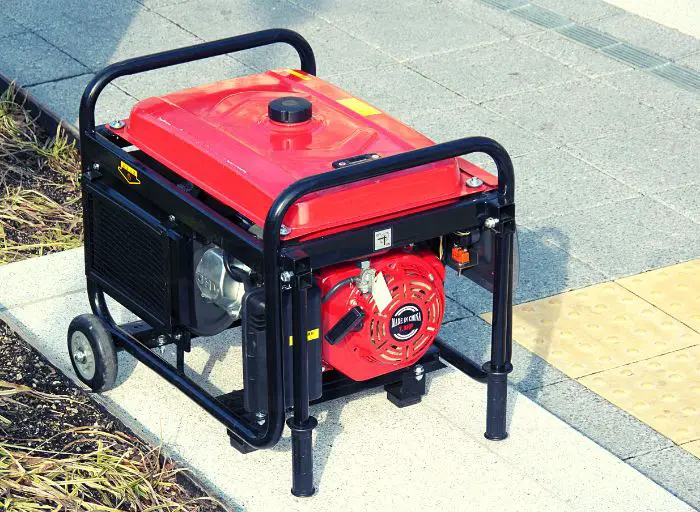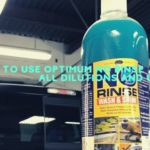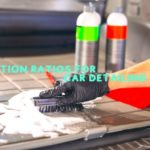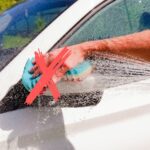
If you’re a mobile vehicle detailer, you’ve probably encountered instances when you couldn’t utilize the client’s power source. Generators are used in this situation. But, you might be wondering, “What generators for car detailing?”
In short, the 3000 Watt inverter generator is the best option for most detailers. This will provide adequate power for all of the tools you’ll need to detail autos.
Table of Contents
Should You Buy Generators for Car Detailing?
You’ll need a generator if you’re pumping water, powering polishers, or running a medium to large detailing business. Remember that a good generator is not inexpensive. If you’re just starting off, you might not want to invest $700-$2000 unless it’s essential. Extension cords and hoses are probably more cost-effective if you’re visiting a customer’s home and have access to water and electricity.
However, employing a generator for car detailing has significant benefits, such as powering vacuums and pumps, pressure washers, and everything else a mobile detailing equipment needs.
The first step is to list all the equipment that requires power. This will assist you in determining which generator is appropriate for your company. The 3000 Watt inverter generator is, on average, the best option.
Basic Terms to Understand the Generators
Before we get started, there are a few things you should know. This can significantly assist you in selecting the appropriate size generator for your vehicle detailing business.
What you should know:
- Continuous power is the number of watts that an inverter generator can continuously distribute. It’s recommended to choose a generator with at least somewhat more continuous power than the gadget you’ll be using it with.
- Maximum or peak power is the maximum number of watts that an inverter generator can produce in a short time. It’s always a little more than the constant power. It’s significant because some tools have a peak power that exceeds the constant power. Therefore, when you first start up a tool, it usually uses more power.
- Watts (W) is a power measurement unit. It’s the quantity of energy required for some tools to perform properly.
- The difference in charge between two places is measured in volts (V). For example, appliances in the United States are typically 110-120 volts, while those in Europe are 220-230 volts.
- The unit of electric current is the ampere (A).
All of these numbers are given in the description of most gadgets. On occasion, though, you may notice that some tools lack Watts numbers. That is why you must understand how to determine the required wattage for certain electric equipment.
Watts are calculated using the formula Amps * Volts = Watts. So, you’ll need to know the Amps and Voltage figures to determine the required power.
For example, a device with 8A and 120V can be used. 8*120=960 Watts. Alternatively, a 6A 220V gadget. 6*220=1320 Watts.
Generator Types
There are two sorts of generators to consider.
# Inverter generators

Inverter generators are ideal for detailers who want mobility.
Homes often prefer traditional generators since they can become large, have large fuel tanks, and run long.
When it comes to detailing, though, you don’t need anything that takes up a lot of room (assuming you don’t already have one). Because you’ll most likely use the generator for up to an hour at a time, an inverter generator should suffice, especially if you don’t need to pump water or run a lot of tools.
Inverter generator advantages
- Due to improved mufflers and quieter engines, these run substantially quieter.
- Portable and light — frequently less than 100 pounds (Honda models are around 47 lbs)
- Microprocessors and other electronics save fuel by alternating engine speeds.
The disadvantages of inverter generators
- Beginners should expect to pay upwards of $1,000 for most items.
- Most larger units have a maximum power output of roughly 4,000 watts, which is insufficient for powering many devices at once.
- Repairs are more expensive.
- They are a little more expensive than other generators, which start at approximately $500, but they are well worth the money.
# Standard multifunctional generators
The normal multifunctional generator is the most popular choice I see many detailers employ for trailer setups.
If you have the space, you can’t go wrong with a simple 3500-watt generator unless you’re working out of a van and need the portability.
Advantages of traditional generators
- Starting price is lower.
- Muffled capability (still louder than inverted generators, but quieter)
- Larger fuel tank for equipment power
- Power ranges from 10,000 to 20,000 watts
The disadvantages of traditional generators
- Bulky and awkward to store and maneuver (especially in vans)
- Some people can be quite noisy (a big deal for office parks, etc.)
- In comparison to inverter generators, they often consume more fuel.
- For pumping water from a tank, conventional generators are ideal.
If you’re using a pressure washer and can’t utilize the customer’s water supply, having a generator on hand is ideal for generating the pumps required by your water tank.
Unless you buy a belt or gear-driven unit washer instead of a cheaper direct drive, most pressure washers require roughly 20 psi of pressure to work. At a minimum, these pressure washers cost $2,000-$3,000, but they do away with the requirement for a generator to pump water. Just something to think about.
For novices, smaller conventional generators are less expensive to operate.
Most bigger 6,000 watt+ generators can use up to 2.5 gallons of petrol every hour, although smaller generators can use as little as a gallon. So unless you have a lot of equipment to power, I would recommend starting with a smaller generator for beginners.
What Size Generator for Mobile Detailing Do You Need?
The size of generator that you will need for mobile detailing depends on what type of detailing services you plan to offer.
- Small-scale mobile detailing operations: If you have basic equipment such as a pressure washer (around 2,000-3,000 watts), a vacuum (around 1,000-1,500 watts), and a few small tools, a generator with a power output of around 4,000-5,000 watts may be sufficient.
- Medium-scale mobile detailing operations: For operations with additional equipment such as multiple pressure washers (3,000-5,000 watts each), larger vacuum systems (1,500-2,500 watts), polishers (500-1,500 watts), and other tools, a generator with a power output of 7,000-10,000 watts may be appropriate.
- Large-scale mobile detailing operations: If you have a high-volume mobile detailing operation with multiple high-powered pressure washers (5,000-8,000 watts each), large vacuum systems (2,500-4,000 watts), multiple polishers (500-1,500 watts each), and other power-hungry equipment, a generator with a power output of 12,000 watts or higher may be necessary.
Also, if your vehicle detailing service includes tools and equipment that need the power to operate (such as an air compressor or pressure washer), then the generator should be able to support those additional loads for sustained periods.
Finally, given the portable nature of mobile detailing work, selecting a lightweight yet reliable generator that can easily move from place to place when needed is important.
What Are the Best Generators for Mobile Detailing?

The best brands on the market are those that offer reliable power, efficient fuel economy, and a variety of features. Generators are essential for car detailers who want to bring the highest quality results for their customers’ vehicles.
Honda Generators is My #1 best generator for mobile detailing
I highly recommend Honda generators based on my research and personal experience. Honda is one of the most trustworthy brands of inverter generators available in the detailing industry; news crews and other organizations appreciate them.
If I had to choose, the Honda EU2200i would be my choice based on Amazon evaluations and testimonials, and it simply lasts longer than many others. With a peak power of 2200W, it’s ideal for mobile detailing and small enough to take any place.
Because the noise from your generator is as quiet as a conversation, you’ll never be bothered by it while running.
Now, let me tell you about the Eco-Throttle system that comes with this generator: depending on how much load the machine has to handle, you get more power and higher fuel efficiency (up to 8 hours of use without charging)
Honda generators are, in general, composed of pure awesomeness. It is one of the most popular mobile detailing generators, and professional detailers and car owners utilize it on a daily basis.
Yamaha Generators
Another popular brand for car detailing generators is Yamaha. The company’s EF2000iSv2 model is ideal for detailers as it has an ultra-quiet engine and operates at just 51 decibels— quieter than normal conversation levels. This generator is also lightweight and designed with CARB (California Air Resources Board) compliance in mind, allowing it to be used even in areas with emissions standards.
WEN Generators
WEN generators offer high performance at an affordable price point. The WEN 56200i 2000-Watt Portable Inverter Generator can provide up to 4 hours of run time on only one gallon of gas while operating at 53 decibels or lower. This generator also features an intuitive control panel and safety features such as low oil shutdown protection as well as overload protection.
Factors to Consider When Choosing a Generator for Car Detailing
When selecting a generator for car detailing, there are several factors to consider in order to ensure that you make the best decision possible.
Size & Weight
First, consider the size and weight of the generator. Generators come in a variety of sizes, from small portables to large-scale stationary units. Make sure you select one that will fit your space and be easy to transport if necessary.
Power
Consider the power output of the generator. If you plan on using high-powered tools and machines for your car detailing projects, ensure your generator can handle that power demand level.
Noise Level
Next, factor in noise output when selecting a generator for car detailing projects. Many generators are quite loud when running, so think about where you will be using them and how loud it may be for those nearby. Some newer models have noise-dampening technology or quieter engines to reduce sound levels while they’re running.
Other Features
For added convenience, look into features such as automatic start/stop capability, fuel shutoff systems, remote controls and maintenance alarms that can help make maintaining and operating your generator much easier.
With all these factors taken into account, you’ll be able to choose the perfect generator for all your car detailing needs.
Tips for Using Generators for Car Detailing
Here are some useful tips for using generators for car detailing:
- Make sure your generator is properly supplied with fuel and all necessary oil changes are up to date. This will ensure that your engine runs smoothly and efficiently when you’re ready to start detailing your car.
- Check the power cords for any wear or damage before connecting them to the generator. Damaged cords can cause electrical shock or even fire, so take extra care when handling them.
- Do not use an extension cord with a generator that has an insufficient wattage rating for the equipment that needs to be powered. If your equipment’s wattage rating exceeds the generator’s rating, it could cause a power overload and lead to potentially dangerous electrical issues.
- When powering your generator’s tools, ensure they’re grounded properly before you start working on your vehicle’s exterior or interior surfaces. A ground-fault preventer should be used in situations where more than one tool is being powered by the same source of electricity, such as when multiple polishers are needed for a full detailing job.
- Always keep an eye on the temperature of your generator while it is in use; if it gets too hot, shut it off immediately and let it cool down before continuing work on your vehicle’s surface areas.
By following these tips, you can ensure that you’re using a safe and reliable method of powering tools while completing detailed car detailing jobs with greater speed and efficiency!
Common Mistakes When Using Generators for Car Detailing
For years working with portable generators, I’ve seen some common mistakes people make, which can lead to dangerous situations.
Not using the correct equipment
Many people are new to car detailing with a generator and use equipment not designed for this purpose. Generators should be specifically designed to power car detailing items such as buffer polishers and extractors. Otherwise, you may end up burning out the motors or damaging the electrical components due to voltage fluctuations.
Not setting up a safe work area
When using any powered equipment, it is important to make sure that your work area is free from debris and other hazards that could cause injury. Besisdes, generators should always be placed outside well-ventilated areas and away from combustible materials to avoid potential fires.
Ignoring maintenance protocols
Regular maintenance of both the generator and any car detailing tools is essential when using them together. Check the manufacturer’s guidelines regularly so you know when it’s time to change the oil, check air filters, or replace spark plugs in order to keep everything running smoothly and avoid any potential repair costs down the road.
Not properly managing cords

It’s also important to manage all electrical cords properly when using generators for car detailing, as they can easily become damaged or even cause electrocution if not handled correctly. Make sure all cords are tucked away securely and out of reach during use so they don’t get caught on moving parts or become snagged by debris in the area.
Some Common Problems with Generators for Car Detailing
Generators used for car detailing operations can encounter various issues that may affect their performance and reliability. Some common problems with generators for car detailing may include:
Engine starting issues
Generators may have difficulty starting due to issues with the ignition system, fuel system, or other components. This can be caused by factors such as stale fuel, clogged fuel lines or filters, a weak battery, or a faulty ignition system.
Power output problems
Generators may experience fluctuations in power output or fail to deliver the required power, which can impact the performance of detailing equipment such as pressure washers or vacuum systems. This can be caused by factors such as improper load balancing, voltage regulator issues, or engine-related problems.
Fuel-related issues
Generators may experience problems related to fuel supply, such as running out of fuel, contaminated fuel, or issues with fuel lines, filters, or carburetors. These issues can affect the generator’s performance and reliability.
Overheating
Generators can overheat due to factors such as extended operation under heavy loads, inadequate cooling, or insufficient ventilation. Overheating can lead to reduced performance, engine damage, and even generator shutdown.
Oil-related issues
Generators require proper oil maintenance, including regular oil changes and adequate oil levels. Failure to maintain proper oil levels or use the recommended oil type can result in engine damage, reduced performance, and increased wear and tear.
General wear and tear
Generators, like any mechanical equipment, can experience general wear and tear over time. This can include issues such as worn-out spark plugs, dirty air filters, loose connections, or worn-out belts, which can impact the generator’s performance and reliability.
Electrical issues
Generators may encounter electrical problems such as faulty wiring, damaged outlets, or issues with the voltage regulator, which can affect the generator’s power output and performance.
Frequently Asked Questions
#1 How does a mobile detailer get electricity?
- Portable generators are fuel-powered and generate AC electrical current for running tools and other equipment needed for detailing services.
- Battery packs allow detailers to store energy from an offsite electrical outlet or from an external solar panel, allowing them to use the stored energy on-site as needed.
- Solar power is also gaining in popularity among mobile detailers as it enables them to use renewable energy sources for their detailing operations. Solar panels are relatively easy to install and require little maintenance, making them a cost-effective choice for many mobile detailers.
#2 How do I use a generator for car detailing?
Using a generator for car detailing is relatively straightforward.
- First, set up the generator and connect it to your power tools and equipment.
- Then, make sure that the fuel tank is full and turn the switch on to start the engine.
- Depending on the size of your generator, you may need to adjust the settings to ensure that your power tools and equipment receive the proper power supply.
- Finally, use your power tools and equipment to perform car detailing as you normally would.
Don’t forget to turn off the generator when done and refill the fuel tank for future use.
#3 How do I care for my generator for car detailing?
To ensure that your generator runs smoothly for car detailing, there are several steps you can take care for the generator.
- Store it indoors if possible and cover it when not in use. If storing outdoors, keep it somewhere dry and out of direct sunlight to prevent exposure to the elements.
- Regularly inspect the engine oil and air filter to ensure they are both clean.
- Change the oil as needed according to your manufacturer’s recommendation.
- Do not forget to check the fuel tank regularly for any leaks or other issues that can compromise its performance.
#4 How often should I change the oil for my generator?
Refer to your generator’s owner manual for instructions on how often you should change your oil and what type is best for your model. However, as a general guideline, it is recommended to change the oil in your generator every 50-100 hours of operation or at least once a year, whichever comes first.
Check out this video for WHEN To BUY A Generator For Your Auto Detailing Business
You’ll need a high-quality and reliable generator if you’re a mobile vehicle detailer. I hope you now know better what size generator you require for your auto detailing business or hobby. More power is always better, so I suggested you have a 3000 Watt generator. Unfortunately, most auto detailing equipment will only function at half of its potential.
To select the right generator for your needs, you will need to consider the type of generator and the factors related to size, power output and portability.
With proper maintenance and use, these generators can provide comfort and convenience for car detailing professionals.
Further Reading:
Hi everyone, My name is Ollie Barker.
As a seasoned auto expert I have 25 years of experience working in repair and detailing shops. I love to share my tips & tricks to all car lovers, so that’s why I’m here at Automotive Gearz publishing my content, sharing my passion. Also, I’ve been giving my recommendations on which products are the best to have on the market. I always thought it was hard to pick the right part, so hopefully I can make that a bit easier for you.
Hope you enjoy your time on my little blog!







